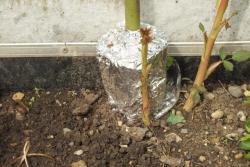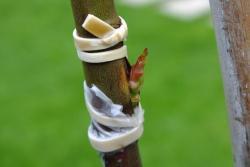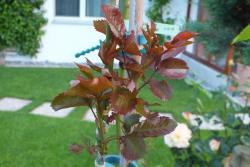A little background info on the conventional production of a standard rose:
It can take up to five years until a plant is ready for sale so the high asking prices are understandable. Here in Europe, Rosa canina ‘Pfänders’ is commonly used to produce rootstock for standards.
Generally, the production steps for standard rootstock are:
Seed is harvested in autumn (Oct) and receives 10 weeks warm and then 10 weeks cold stratification.
1st year – seeds are sown in March. The seedlings are harvested in autumn and put into storage. Selected plants should have a diameter of 8 to 12mm.
2nd year– replanted in March and grown in the field for 2 years where they can produce canes up to 2.5m. During the 2nd and 3rd growing season, all the side shoots are removed, leaving one for the stem.
4th year – the standards are budded/grafted in Jul/Aug.
5th year – standard roses are ready for sale.
So how to utilize those rootstock suckers coming off your rose that died to make a standard rose?
One option is to remove all but one cane and bud it in the second season. However, you will only have one new standard rose and all the other canes will have been wasted. The other option would be to leave all the suckers so that you have multiple canes to root.
For a standard rose you need to root very tall rootstock canes. Standards can range anything between 60cm to 180cm and even taller. Rooting taller canes the traditional way can be difficult – the taller the cane the lower the success rate.
The main problem is the sap flow in the longer canes. The internet is full of suggestions on how to do this. A popular one is the "milk container method," whereby the cane is placed in a 2l milk container with drainage holes filled with 80/20 sand/peat mixture and laid on its side until the leaf buds start swelling and then slowly lifted as the leaves start growing. I haven’t tried this and therefore cannot comment on the success rate.
There is, however, a method which offers a close on 100% success rate: air-layering, and it isn’t difficult. This method involves removing a ring of bark/cambium layer down to the woody tissue, leaving the cane attached to the mother plant. The area of exposed woody tissue is surrounded with moistened sphagnum moss (I have also used potting soil and coir), which is wrapped in plastic and held in place and sealed, top and bottom, with ties or tape. Cover with aluminium foil to protect from sunlight.
An additional advantage of air-layering canes to make a standard rose is that rooting and budding can be done simultaneously because there is sufficient sap flow to the top of the canes, which will ensure that the graft takes.
Now, April – May, when the canes are showing new green growth, is a good time to take canes staked in the previous year and air-layer them. The canes can also be grafted now. Chip budding can be done any time of the year, but for T-budding the bark has to slip. There isn’t much bud wood around in the garden at the moment, but try some florist roses. I have had great success budding florist roses as opposed to trying to root them.
1. Prepared air-layered cane from the previous year – photo taken 25 May 2015

2. Example chip-budding grafted on 11 May 2015 – photo taken 25 May 2015

3. Example T-budding grafted on 11 May 2015 – photo taken 25 May 2015

4. Successfully grafted florist roses grafted 11 May 2015 – photo taken 6 June 2015

5. Example finished standard roses - grafted and rooted in 2014

6. Example tree roses with multiple grafts – grafted and rooted in 2014

PS: When propagating roses, please respect breeder’s rights!
| Thread Title | Last Reply | Replies |
|---|---|---|
| How to remove bud-eyes before grafting. by vaporvac | Aug 7, 2019 11:11 AM | 0 |
| ungrafted rose standard canes. by johndane | Aug 7, 2019 11:08 AM | 2 |